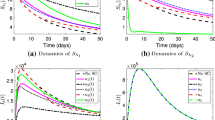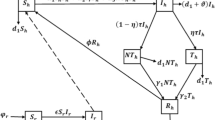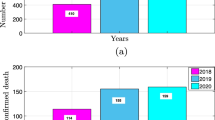Abstract
In this study, we extend an existing Lassa fever model by incorporating four time-dependent control functions which are identified as a preventive strategy, treatment care, and rodent reduction. The six compartmental nonlinear optimal control problem is developed and analyzed. We employed Pontryagin’s maximum principle for the analytical characterization of the optimality system, and we established control measures suitable for reducing the spread of Lassa fever in the community. Numerical simulations of the optimality system were performed on Matlab using the fourth-order Runge–Kutta forward-backward sweep method, to demonstrate the theoretical findings. We further carried out a comprehensive cost-effective analysis to investigate the strategy that is most cost-effective among all the eleven combinations of control implementation. The results reveal that the single preventive strategy targeted at preventing the transmission of the Lassa virus from infectious rodents to humans is considered the most cost-effective strategy among others in this study. Overall, this research sheds light on the cost of each combination of control strategies, informing the public about the strategy to implement based on the population’s financial resources.













Similar content being viewed by others
Data Availability
All data supporting the findings of this study are included in the list of references.
Code Availability
Code can be made available to readers upon request.
References
Musa SS, Zhao S, Gao D, Lin Q, Chowell G, He D (2020) Mechanistic modelling of the large-scale lassa fever epidemics in Nigeria from 2016 to 2019. J Theor Biol 493:110209
Ojo MM, Gbadamosi B, Benson TO, Adebimpe O, Georgina A (2021) Modeling the dynamics of lassa fever in Nigeria. J Egypt Math Soc 29(1):1–19
Maxmen A (7697) Deadly lassa-fever outbreak tests Nigeria’s revamped health agency. Nature, 555
Ojo MM, Goufo ED. Modeling, analyzing and simulating the dynamics of lassa fever in Nigeria. J Egypt Math Soc 30(1)
Akinpelu F, Ojo M (2016) Mathematical analysis of effect of isolation on the transmission of ebola virus disease in a population. Asian Res J Math, 1–12
Doungmo Goufo EF, Oukouomi Noutchie SC, Mugisha S (2014) A fractional seir epidemic model for spatial and temporal spread of measles in metapopulations. In: Abstract and applied analysis, vol 2014, Hindawi
Goufo EFD, Pene MK, Mugisha S (2016) Stability analysis of epidemic models of ebola hemorrhagic fever with non-linear transmission. J Nonlinear Sci Appl 9(6):4191–4205
Ojo M, Akinpelu F. Lyapunov functions and global properties of seir epidemic model. Int J Chem Math Phys 1(1)
Oke SI, Ojo MM, Adeniyi MO, Matadi MB (2020) Mathematical modeling of malaria disease with control strategy. Commun Math Biol Neurosci, 2020 Article-ID
Akinpelu F, Ojo M (2016) A mathematical model for the dynamic spread of infection caused by poverty and prostitution in Nigeria. Int J Math Phys Sci Res 4:33–47
Gbadamosi B, Ojo MM, Oke SI, Matadi MB (2018) Qualitative analysis of a dengue fever model. Math Comput Appl 23(3):33
Gibb R, Moses LM, Redding DW, Jones KE (2017) Understanding the cryptic nature of lassa fever in West Africa. Pathogens Glob Health 111(6):276–288
Zhao S, Musa SS, Fu H, He D, Qin J, Large-scale lassa fever outbreaks in nigeria: quantifying the association between disease reproduction number and local rainfall. Epidemiol Infect, 148
Bakare E, Are E, Abolarin O, Osanyinlusi S, Ngwu B, Ubaka ON (2020) Mathematical modelling and analysis of transmission dynamics of lassa fever. J Appl Math
Dachollom S, Madubueze CE (2020) Mathematical model of the transmission dynamics of lassa fever infection with controls. Math Model Appl 5:65–86
Davies J, Lokuge K, Glass K (2019) Routine and pulse vaccination for lassa virus could reduce high levels of endemic disease: a mathematical modelling study. Vaccine 37(26):3451-3456
Ojo M, Akinpelu F (2017) Sensitivity analysis of ebola virus model. Asian Res J Math, 1–10
Abioye AI, Peter OJ, Ogunseye HA, Oguntolu FA, Oshinubi K, Ibrahim AA, Khan I (2021) Mathematical model of covid-19 in Nigeria with optimal control. Results Phys 28:104598
Ojo MM, Doungmo Goufo EF (2021) Assessing the impact of control interventions and awareness on malaria: a mathematical modeling approach. Commun Math Biol Neurosci, 2021 Article-ID
Ayoade AA, Peter O, Ayoola T, Oguntolu F, Amadiegwu S, Abioye A. Optimal intervention strategies for transmission dynamics of cholera disease
Ibrahim MA, Dénes A (2021) A mathematical model for lassa fever transmission dynamics in a seasonal environment with a view to the 2017–20 epidemic in nigeria. Nonlinear Anal Real World Appl 60:103310
Peter OJ, Abioye AI, Oguntolu FA, Owolabi TA, Ajisope MO, Zakari AG, Shaba TG (2020) Modelling and optimal control analysis of lassa fever disease. Inform Med Unlocked 20:100419
Onah IS, Collins OC (2020) Dynamical system analysis of a lassa fever model with varying socioeconomic classes. J Appl Math
Ojo MM, Benson TO, Shittu AR, Doungmo Goufo EF (2022) Optimal control and cost-effectiveness analysis for the dynamic modeling of lassa fever. J Math Comput Sci, 12 Article-ID
Pontryagin L, Boltyanskii V, Gamkrelidze R, Mishchenko E, The maximum principle. In: The mathematical theory of optimal processes. Wiley, New York
Fleming WH, Rishel RW (2012) Deterministic and stochastic optimal control, vol 1. Springer, Berlin
Adepoju OA, Olaniyi S (2021) Stability and optimal control of a disease model with vertical transmission and saturated incidence. Scientific African, e00800
Asamoah JKK, Okyere E, Abidemi A, Moore SE, Sun G-Q, Jin Z, Acheampong E, Gordon JF. Optimal control and comprehensive cost-effectiveness analysis for covid-19, arXiv preprint arXiv:2107.09595
Agusto F, Leite M (2019) Optimal control and cost-effective analysis of the (2017) meningitis outbreak in nigeria. Infect Dis Model 4:161–187
Funding
There was no funding available for this work.
Author information
Authors and Affiliations
Contributions
Mayowa M. Ojo: Conceptualization, Methodology, Software, Validation, Writing- Original draft, Visualization, Formal analysis. Emile Franc Doungmo Goufo: Supervision, Writing-Review, and Editing.
Corresponding author
Ethics declarations
Conflict of interest
The authors declare that they have no conflict of interest.
Ethical Statement
The authors hereby declare that this manuscript is the result of our independent creation under the reviewer’s comments. Except for the quoted contents, this manuscript does not contain any research achievements that have been published or written by other individuals or groups. The legal responsibility of this statement shall be borne by the authors.
Rights and permissions
About this article
Cite this article
Ojo, M.M., Goufo, E.F.D. Mathematical analysis of a Lassa fever model in Nigeria: optimal control and cost-efficacy. Int. J. Dynam. Control 10, 1807–1828 (2022). https://doi.org/10.1007/s40435-022-00951-3
Received:
Revised:
Accepted:
Published:
Issue Date:
DOI: https://doi.org/10.1007/s40435-022-00951-3




